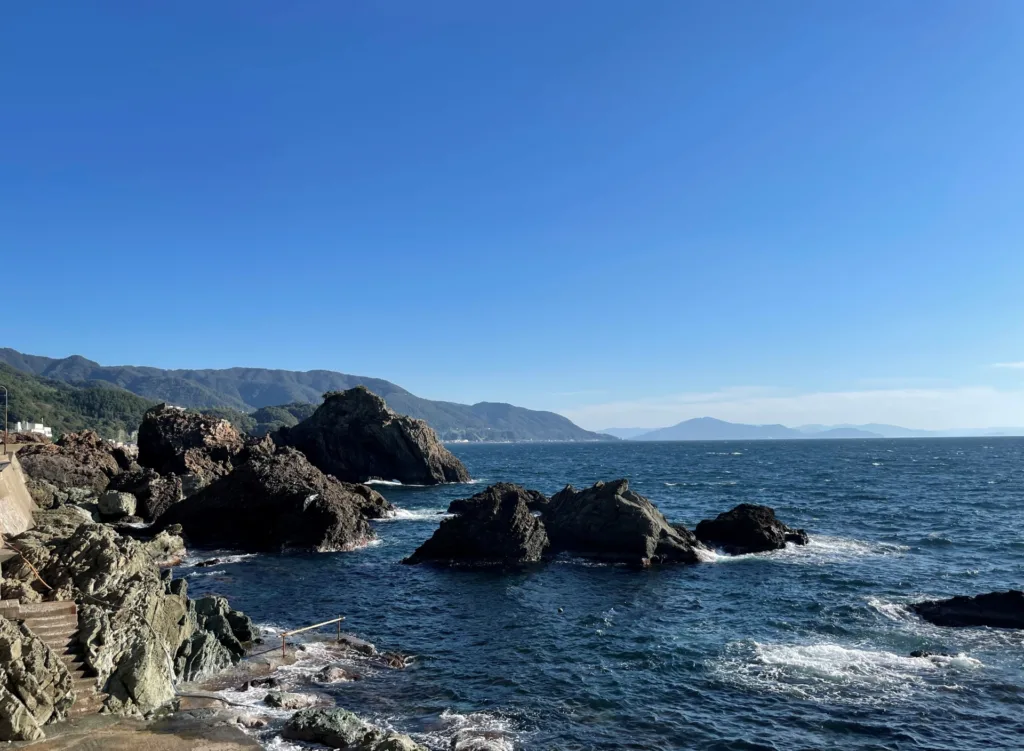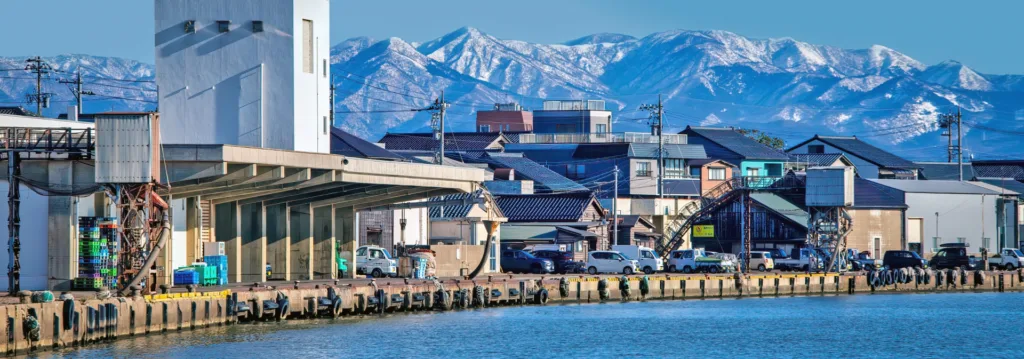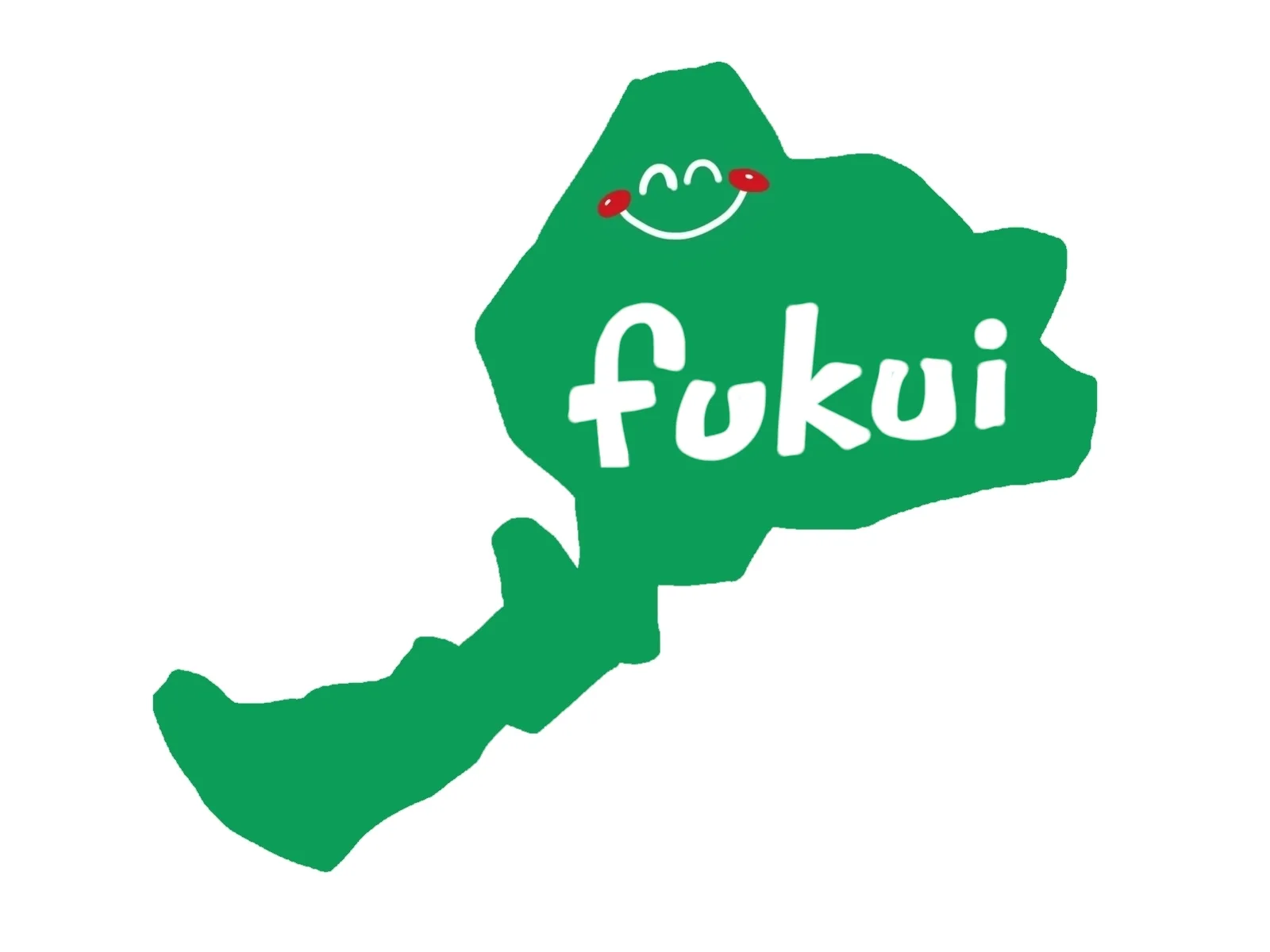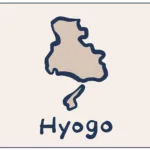Fukui Prefecture is located in the Chubu (Hokuriku) region of Japan, bordered by Ishikawa Prefecture to the east, Gifu and Shiga Prefectures to the south, and Kyoto Prefecture to the west. Facing the Sea of Japan, this region offers a harmonious blend of rich natural beauty and deep historical culture. As represented by the term “Etsuzan Jakusui” (越山若水), which refers to “the green mountains of Echizen and the clear waters of Wakasa,” Fukui is blessed with an environment of mountains and sea.
Fukui Prefecture has been ranked as Japan’s number one prefecture in the happiness ranking and offers beautiful natural landscapes, historical buildings, delicious food, and traditional crafts. Here, we introduce popular tourist destinations in Fukui Prefecture that are popular with international visitors.
- 1. Tojinbo Cliffs – A Spectacular Natural Wonder
- 2. Fukui Prefectural Dinosaur Museum – Symbol of the Dinosaur Kingdom
- 3. Eiheiji Temple – A Zen Training Monastery
- 4. Shibamasa World – A Family-Friendly Resort
- 5. Ichijodani Asakura Clan Ruins – Visiting a Medieval Castle Town
- 6. Echizen Coast and Mikatagoko Lakes – Enjoying Natural Landscapes
- 7. Maruoka Castle – Japan’s Oldest Existing Castle Tower
- 8. Awara Onsen – The Back Parlor of the Hokuriku Region
- 9. Echizen Washi Village – Experiencing Traditional Crafts
- 10. Megane Museum – The Holy Land of the Eyewear Industry
- 11. Mikatagoko Rainbow Line Mountaintop Park – Overlooking a Magnificent View
- 12. Mikuni Port Town – A Historic Port Town
- 13. Wakasa Food Culture – Enjoying Fine Cuisine
- 14. Echizen Gani (Snow Crab) – The King of Winter Delicacies
- 15. Fukui Local Cuisine – Unique Food Culture
- Summary
1. Tojinbo Cliffs – A Spectacular Natural Wonder

Tojinbo is a series of rugged cliffs located in Sakai City, Mikuni Town, Fukui Prefecture, and is designated as a national natural monument and scenic spot. The columnar joint rock formations extending for about 1 km along the coastline create a magnificent landscape shaped by the rough waves of the Sea of Japan.
Features and Highlights
Geologically Rare Structure: The columnar joints at Tojinbo are formed from pentagonal or hexagonal cracks in the rock that appeared when magma cooled and solidified. This large-scale columnar joint formation is said to exist in only three places in the world: Mount Geumgang on the Korean Peninsula, the west coast of Norway, and Tojinbo, making it extremely valuable from a geological standpoint.
Origin of the Name: The name “Tojinbo” is derived from a monk named Tojinbo who lived at Heisenji Hakusan Shrine (in Katsuyama City, Fukui Prefecture) during the Heian period. According to legend, Tojinbo was made drunk and pushed off these cliffs by a rival monk who held a grudge against him over a love affair.
Ways to Enjoy the Scenery:
- Sightseeing Boat: A sightseeing boat allows you to view the Tojinbo cliffs from the sea, offering a powerful perspective of the rock faces from angles not visible from land.
- Tojinbo Tower: The 55-meter observation tower offers a panoramic view not only of Tojinbo but also of Echizen Cape and the Hakusan mountain range on clear days.
- Sunset Viewing: The scenery of the sun setting over the Sea of Japan with Tojinbo’s silhouette is spectacular and has been selected as one of “Japan’s 100 Best Sunset Views.”
Nearby Attractions: Near Tojinbo, there is a walking path along the coast and a small island called Oshima, where you can further enjoy the natural landscape.
2. Fukui Prefectural Dinosaur Museum – Symbol of the Dinosaur Kingdom

Fukui Prefecture is known as the “Dinosaur Kingdom” as about 80% of the dinosaur fossils excavated in Japan have been discovered in Fukui. The Fukui Prefectural Dinosaur Museum in Katsuyama City is one of the world’s three great dinosaur museums and Japan’s largest museum specializing in geology and paleontology.
Features and Highlights

Exhibitions:
- Dinosaur Skeleton Display: 50 dinosaur full-body skeletons are on display, 10 of which use actual fossils.
- Giant Diorama: A life-sized diorama recreating the landscape of China’s Sichuan Province during the Mesozoic Era offers an impressive viewing experience.
- Dino Theater: Powerful imagery allows visitors to experience the world of the dinosaur age.
2023 Renovation: The museum underwent a major renovation in July 2023, with a new building addition and enhanced exhibits.
Fossil Excavation Experience: The museum offers activities such as fossil cleaning and excavation experiences. There are four programs available, including extracting dinosaur teeth using actual tools, observing fossils using CT images, excavating and identifying fossils, and assembling a Tyrannosaurus rex skull to learn about bone structure.
Outdoor Dinosaur Museum: This is a tour-style facility that can be accessed by a dedicated bus from the Dinosaur Museum, allowing visitors to see Japan’s largest dinosaur fossil excavation site.
3. Eiheiji Temple – A Zen Training Monastery

Located in Eiheiji Town, Yoshida County, Fukui Prefecture, Eiheiji is a Soto Zen Buddhist temple and, along with Sojiji Temple, is one of the central temples of Soto Zen Buddhism in Japan.
Features and Highlights
History: Eiheiji was founded in 1244 (Kangen 2) by Zen Master Dogen as a Zen training monastery. The temple’s name is derived from the Chinese era name “Yongping” (Eiping in Japanese) when Buddhism was first introduced to China during the reign of Emperor Ming of the Later Han Dynasty, and means “eternal peace.”
Architecture and Grounds:
- Seven Main Buildings (Shichido Garan): The temple grounds contain over 70 buildings, with the “Shichido Garan” (seven main buildings: Hatto, Butsuden, Sodo, Kuin, Sanmon, Tosu, and Yokushitsu) being particularly important as central structures for practice. These buildings are connected by covered corridors.
- Corridors: The seven main buildings are connected by corridors called “kairou,” allowing visitors to move between them.
Zen Practice Experience:
- Zazen (Seated Meditation) Experience: Eiheiji offers zazen experiences for the general public.
- Overnight Temple Stay: For those who want to experience the Zen world more deeply, there are temple stays with overnight accommodation.
Seasonal Scenery: Eiheiji shows beautiful scenery in all four seasons. The autumn foliage season and snowy landscape in winter particularly enhance its solemn atmosphere.
4. Shibamasa World – A Family-Friendly Resort

Shibamasa World, located in Mikuni Town, Sakai City, is a comprehensive leisure facility with a vast site overlooking the Sea of Japan. It offers various attractions throughout the four seasons, and is particularly crowded with tourists during the summer pool season.
Features and Highlights
Vast Grounds and Facilities: The 560,000 square meter grounds include various facilities surrounded by lush lawns.
Main Attractions:
- Dinosaur Forest: Opened in March 2024, this is one of Japan’s largest dinosaur attractions featuring over 60 dinosaurs of 30 different species. Visitors can explore a vast 26,000 square meter forest inhabited by dinosaurs while taking on the mission of collecting the mysterious “Dino Energy.”
- Kids Paradise: This is a three-story indoor facility with 13 attractions that can be enjoyed regardless of weather conditions.
Summer Pool Area:
- Diverse Pool Facilities: The area features 50 water slides of various sizes, a wave pool overlooking the Sea of Japan, and a flowing pool, among other attractions.
- Night Pool: During the summer vacation period, night operations are also conducted, allowing visitors to enjoy a different atmosphere from the daytime.
Auto Campsite: Shibamasa World also has an auto campsite on site. It is popular with families as a complex-type campsite that combines amusement facilities with nature.
5. Ichijodani Asakura Clan Ruins – Visiting a Medieval Castle Town

The Ichijodani Asakura Clan Ruins in Fukui City are the remains of a castle town that flourished during the warring states period under the Asakura clan, and are designated as a special historic site and special place of scenic beauty.
Features and Highlights
Historical Background: The Asakura clan was a feudal lord who controlled Echizen Province from the 15th to the 16th century and established their base in Ichijodani. However, they were destroyed in 1573 when they were attacked by Oda Nobunaga, and the castle town was burned down.
Highlights:
- Reconstructed Town: About 200 meters of the samurai residences and townspeople’s streets have been reconstructed, allowing visitors to glimpse the lifestyle of the time.
- Gardens: Four samurai residence gardens (Nanyo-ji Temple Site Garden, Suwa-yakata Site Garden, Yudono Site Garden, and Front Garden) are designated as special places of scenic beauty. Visitors can learn about the garden design and stonework techniques of the time.
- Excavated Items Display: Items excavated from the site such as daily utensils and weapons are displayed at the Fukui Prefectural Ichijodani Asakura Clan Ruins Museum.
6. Echizen Coast and Mikatagoko Lakes – Enjoying Natural Landscapes
The coastline of Fukui Prefecture is dotted with beautiful natural landscapes. The rugged cliffs of the Echizen Coast and the Mikatagoko Lakes facing Wakasa Bay are scenic spots that captivate visitors.
Echizen Coast Features and Highlights

Landscape: The Echizen Coast is about 20 km of coastline facing the Sea of Japan, characterized by alternating rugged rock formations and beautiful sandy beaches.
Suishohama Beach: This beautiful beach is selected as one of “Japan’s 55 Best Swimming Beaches” and features white sandy beaches and crystal-clear water. “The beautiful blue sea and sparkling white sandy beaches make this one of the most popular beaches in Fukui Prefecture, attracting many beachgoers from both within and outside the prefecture.”
Echizen Misaki Suisen Land: In winter, it becomes a famous spot for daffodils, known as one of Japan’s three great daffodil colony sites.
Mikatagoko Lakes Features and Highlights

Five Lakes: Mikatagoko refers to five lakes (Lake Suigetsu, Lake Suga, Lake Mikata, Lake Kugushi, and Lake Hiruga) located in Wakasa Town and Mihama Town, Fukui Prefecture, facing Wakasa Bay.
Rainbow Line: This is a toll road leading to a mountaintop park overlooking the Mikatagoko Lakes, offering spectacular views from the summit.
7. Maruoka Castle – Japan’s Oldest Existing Castle Tower

Maruoka Castle in Maruoka Town, Sakai City, Fukui Prefecture, is known as the oldest existing castle tower in Japan. It is also famous as a cherry blossom viewing spot, attracting many tourists in spring.
Features and Highlights
History: Maruoka Castle was built in 1576 (Tensho 4) by Shibata Katsutoyo, a retainer of Shibata Katsuie. The current castle tower was rebuilt in the early Edo period and is designated as an important cultural property.
Castle Tower Features: The three-story, five-level turret-style castle tower has a beautiful contrast of white walls and stone walls, and displays weapons and historical documents inside.
Cherry Blossom Spot: Maruoka Castle is also selected as one of the “100 Best Cherry Blossom Spots in Japan,” with about 400 Somei Yoshino cherry trees blooming in spring.
8. Awara Onsen – The Back Parlor of the Hokuriku Region

Awara Onsen in Awara City, Fukui Prefecture, is one of the representative hot spring areas in the Hokuriku region. It opened in 1883 (Meiji 16) and is known as a historic hot spring with over 140 years of history.
Features and Highlights
Hot Spring Characteristics: A unique feature of Awara Onsen is that each inn has its own source, resulting in slightly different water quality from inn to inn. It is generally neutral to slightly alkaline chloride mineral spring water, known for its skin-beautifying effects.
Yunomachi Yokocho: This is a food stall village in the center of the hot spring town where you can casually enjoy local cuisine.
Ashiyu: This is a foot bath set up in the hot spring town where you can casually experience the hot spring.
Surrounding Sightseeing: Awara Onsen also has good access to major tourist spots in Fukui Prefecture such as Tojinbo, Eiheiji Temple, and Mikuni Port, making it convenient as a base for sightseeing.
9. Echizen Washi Village – Experiencing Traditional Crafts
Imadatemachi, Echizen City, Fukui Prefecture, is known as a production area for Echizen Washi paper with over 1,500 years of history. At “Echizen Washi Village,” you can observe the traditional papermaking process and experience making washi paper.
Features and Highlights

History: Echizen Washi is one of Japan’s three major washi papers (Echizen Washi, Mino Washi, and Tosa Washi), with a history dating back to before the Nara period.
Papermaking Experience: The popular papermaking experience program allows you to make your own washi paper and take it home as a souvenir.
Exhibition Facilities: At “Papyrus Hall,” you can observe the traditional washi manufacturing process, and at “Udatsu Craft Hall,” you can learn about the history and culture of Echizen Washi.
10. Megane Museum – The Holy Land of the Eyewear Industry
Sabae City, Fukui Prefecture, is known as the “Holy Land of Eyewear” as it accounts for over 90% of Japan’s eyeglass frame production. At the “Megane Museum,” you can learn about the history and technology of Fukui’s eyewear industry.
Features and Highlights
Historical Exhibition: The museum area, where you can learn about the history of Fukui’s eyewear industry, introduces the techniques and history of a tradition that has continued for over 100 years.
Experience Workshop: Various experience programs are available, from simple keychain making to authentic eyeglass making where you can choose from the materials.
Shop & Cafe: The facility also has a cafe serving selected sweets from Sabae City and home-roasted coffee, allowing you to enjoy shopping and relaxation.
11. Mikatagoko Rainbow Line Mountaintop Park – Overlooking a Magnificent View

This mountaintop park overlooks the Mikatagoko Lakes, spanning Mihama Town and Wakasa Town in Fukui Prefecture. Visitors can enjoy the beautiful scenery created by the Sea of Japan and the five lakes.
Features and Highlights
View Terraces: Five terraces designed with the concept of “floating terraces over Mikatagoko Lakes” offer views of the five lakes from different angles.
Rainbow Line: This approximately 11.2 km toll road leading to the mountaintop park allows you to enjoy beautiful scenery while driving through nature.
Seasonal Scenery: You can enjoy the beauty of all four seasons: the fresh greenery of spring, the blue sky and lake waters of summer, the autumn foliage, and the snowy landscape of winter.
12. Mikuni Port Town – A Historic Port Town

Mikuni Port in Mikuni Town, Sakai City, Fukui Prefecture, is a historic port town that once flourished as a port of call for Kitamaebune ships. The townscape with buildings from the Edo to Meiji periods conveys its prosperity to the present day.
Features and Highlights
Former Morita Bank Headquarters: This Western-style building constructed during the Meiji era is now open to the public as “Mikuni Ryusho-kan.”
Former Kishina Residence: This is the mansion of a Kitamaebune shipowner from the late Edo period, where you can glimpse the lifestyle of wealthy merchants of the time.
Mikuni Minato Machiya-kan: This is a museum converted from a Meiji-era townhouse, exhibiting the history and culture of Mikuni Port.
13. Wakasa Food Culture – Enjoying Fine Cuisine
The Wakasa region of Fukui Prefecture is a treasure trove of food blessed with the bounty of the Sea of Japan and clear water.
Characteristic Food Culture

Wakasa Fugu (Pufferfish): Wakasa fugu, which is in season in winter, is known for its firm flesh and good taste.
Wakasa Guji (Red Tilefish): Red tilefish, known as a luxury fish, is particularly high quality when caught in Wakasa Bay.
Heshiko: This is a traditional preserved food made by salting fish such as mackerel or sardines and then pickling them in rice bran to mature.
14. Echizen Gani (Snow Crab) – The King of Winter Delicacies

The most famous winter delicacy in Fukui Prefecture is “Echizen Gani.” This is a brand name given only to male snow crabs, and they are in season from the opening day of November 6 until the end of March.
Features and Appeal
Quality and Brand: Echizen Gani is identified by a yellow tag as a mark of the brand and is known as the only “imperial offering crab” in Japan. It is also the first crab in Japan to be registered for GI (Geographical Indication Protection System).
How to Enjoy: It is common to enjoy its sweetness and umami with simple cooking methods such as “kani-suki” (crab hot pot) or boiled crab.
Where to Eat: There are many restaurants serving Echizen Gani in the main port towns and hot spring areas along the Sea of Japan coast in Fukui Prefecture. Mikuni Town and Echizen Town in Sakai City, and Fukui City are particularly famous.
15. Fukui Local Cuisine – Unique Food Culture
Fukui Prefecture has many local dishes that have developed uniquely and are beloved by locals.
Characteristic Dishes
Sauce Katsudon: This is a rice bowl topped with thinly sliced pork cutlet coated with breadcrumbs, fried, and covered with a special sauce. It is widely known as a representative B-grade gourmet of Fukui Prefecture.

Oroshi Soba: This is a standard Fukui soba dish with plenty of grated daikon radish on top of cold soba noodles, eaten with condiments. A characteristic of Fukui’s food culture is eating cold soba even in winter.

Borga Rice: Originating in Takefu City (now Echizen City), Fukui Prefecture, this is a hearty dish with an omelet topped with a pork cutlet and covered with a special sauce.
Mizuyokan: In Fukui, mizuyokan (water jelly) is enjoyed year-round, not just in summer, as evidenced by the saying “winter is mizuyokan by the kotatsu.” It has a soft and juicy texture, and each store has its own unique flavor and design.

Summary

Fukui Prefecture is an attractive tourist destination with rich natural beauty facing the Sea of Japan and deep historical culture. The rugged cliffs of Tojinbo, the world-class exhibitions at the Fukui Prefectural Dinosaur Museum, the solemn training monastery of Eiheiji, and the delicious seafood and local cuisine offer visitors a variety of experiences.
With the extension of the Hokuriku Shinkansen on March 16, 2024, access from Tokyo to Fukui has been greatly improved, with a fastest journey time of 2 hours and 51 minutes. Why not fully enjoy the nature, history, and food culture in Fukui Prefecture, which has become even more accessible?
Furthermore, Fukui Prefecture has been selected as a noteworthy travel destination by The Washington Post as one of the “Places to Travel in 2024.” For travelers who want to avoid crowds and experience Japanese traditions and nature, Fukui Prefecture can be said to be an ideal destination.


コメント